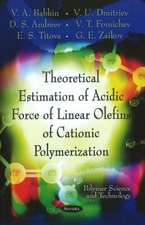Aging and Stabilization of Polymers
Autor M. B. Neimanen Limba Engleză Paperback – 12 feb 2012
Preț: 395.85 lei
Nou
Puncte Express: 594
Preț estimativ în valută:
75.76€ • 78.26$ • 63.05£
75.76€ • 78.26$ • 63.05£
Carte tipărită la comandă
Livrare economică 26 martie-09 aprilie
Preluare comenzi: 021 569.72.76
Specificații
ISBN-13: 9781461585510
ISBN-10: 1461585511
Pagini: 376
Ilustrații: X, 366 p.
Dimensiuni: 170 x 244 x 20 mm
Greutate: 0.6 kg
Ediția:1965
Editura: Springer Us
Colecția Springer
Locul publicării:New York, NY, United States
ISBN-10: 1461585511
Pagini: 376
Ilustrații: X, 366 p.
Dimensiuni: 170 x 244 x 20 mm
Greutate: 0.6 kg
Ediția:1965
Editura: Springer Us
Colecția Springer
Locul publicării:New York, NY, United States
Public țintă
ResearchCuprins
Introduction: Significance and Prospects of the Stabilization of Polymers and Articles Made from Them.- I. Mechanism of the Thermooxidative Destruction and Stabilization of Polymers.- 1. Oxidation in the Gas and Liquid Phases.- 2. Oxidation in the Solid Phase.- 3. Oxidation in Polypropylene.- 4. Autoinhibition of the Oxidation of Polymers.- 5. Critical Concentration of Antioxidants.- 6. Initiation of Oxidation by Antioxidants.- 7. Theory of Synergism.- 8. Free Radicals as Stabilizers.- 9. Boric Stabilizers.- II. Stable Radicals of Inhibitors of Oxidative Processes.- 1. Phenoxyl Radicals.- 2. Stable Radicals of Naphthols.- 3. Stable Radicals of Aromatic Amines.- 4. Formation of Stable Radicals of Inhibitions During Oxidation Processes.- III. Synthesis of Stabilizers for Polymer Materials.- I. Photostabilizers.- II. Antioxidants.- IV. Aging and Stabilization of Polyolefins.- I. Oxidative Destruction of Polyolefins.- II. Stabilization of Polyolefins Against Oxidative Destruction.- III. Destruction of Polyolefins Under the Action of Light.- IV. Increasing the Light Stability of Polyolefins.- V. Aging and Stabilization of Polyformaldehyde.- 1. Thermal and Thermooxidative Destruction.- 2. Stabilization of Polyformaldehyde.- 3. Bonding of Formaldehyde by Polyamides.- 4. Inhibition of the Process of Oxidation of Polyformaldehyde by Inhibitors, Derivatives of Aromatic Amines and Phenols, Phosphites, and Sulfur-Containing Compounds.- 5. Inhibition of the Oxidation of Polyformaldehyde by Radical-Type Inhibitors.- 6. Consumption of Nitrogen Oxide Stable Radicals in the Thermal Oxidation of Polyformaldehyde.- VI. Aging and Stabilization of Polyvinyl Chloride and Copolymers of Vinyl Chloride.- I. Factors Determining the Mechanism and Rate of Decomposition of Polyvinyl Chloride.- II.General Principles of the Stabilization of Polyvinyl Chloride.- III. Methods of Evaluating the Effectiveness of the of the Action of Polyvinyl Chloride Stabilizers.- IV. Stabilizers of Polyvinyl Chloride and Vinyl Chloride Copolymers.- VII. Aging and Stabilization of Polyamides.- I. Thermal Aging of Polyamides.- II. Thermal Oxidation of Polyamides.- III. Stabilization of Polyamides Against Thermal Oxidation.- IV. Photoaging of Polyamides.- V. Photostabilization of Polyamides.- VIII. Aging of Certain Condensation Polymers.- I. Epoxide Resins.- II. Phenol-Formaldehyde Resins.- III. Polyarylates.- IV. Polycarbonate.- IX. Aging of Polymers with Inorganic Principal.- Chains of the Molecules, Framed by Organic Groups.- X. Aging and Stabilization of Raw and Cured Rubbers.- I. Thermal Oxidation of Raw Rubbers in the Presence of Inhibitors.- II. Thermal Oxidation of Cured Rubbers.- III. Light Aging.- IV. Aging of Raw Rubbers at High Temperatures.- V. Corrosion Cracking of Cured Rubbers.- VI. Aging of Polymers Under the Action of Ionizing Radiations.- VII. Influence of Mechanical Stresses on the Aging of Cured Rubbers.- XI. Mechanochemical Processes in Highly Elastic Polymers.- I. Cleavage of the Macromolecule.- II. Mechanochemical Phenomena in the Case of Repeated Deformation of Highly Elastic Polymers.- III. Mechanochemical Phenomena in the Reprocessing of Highly Elastic Polymers.









